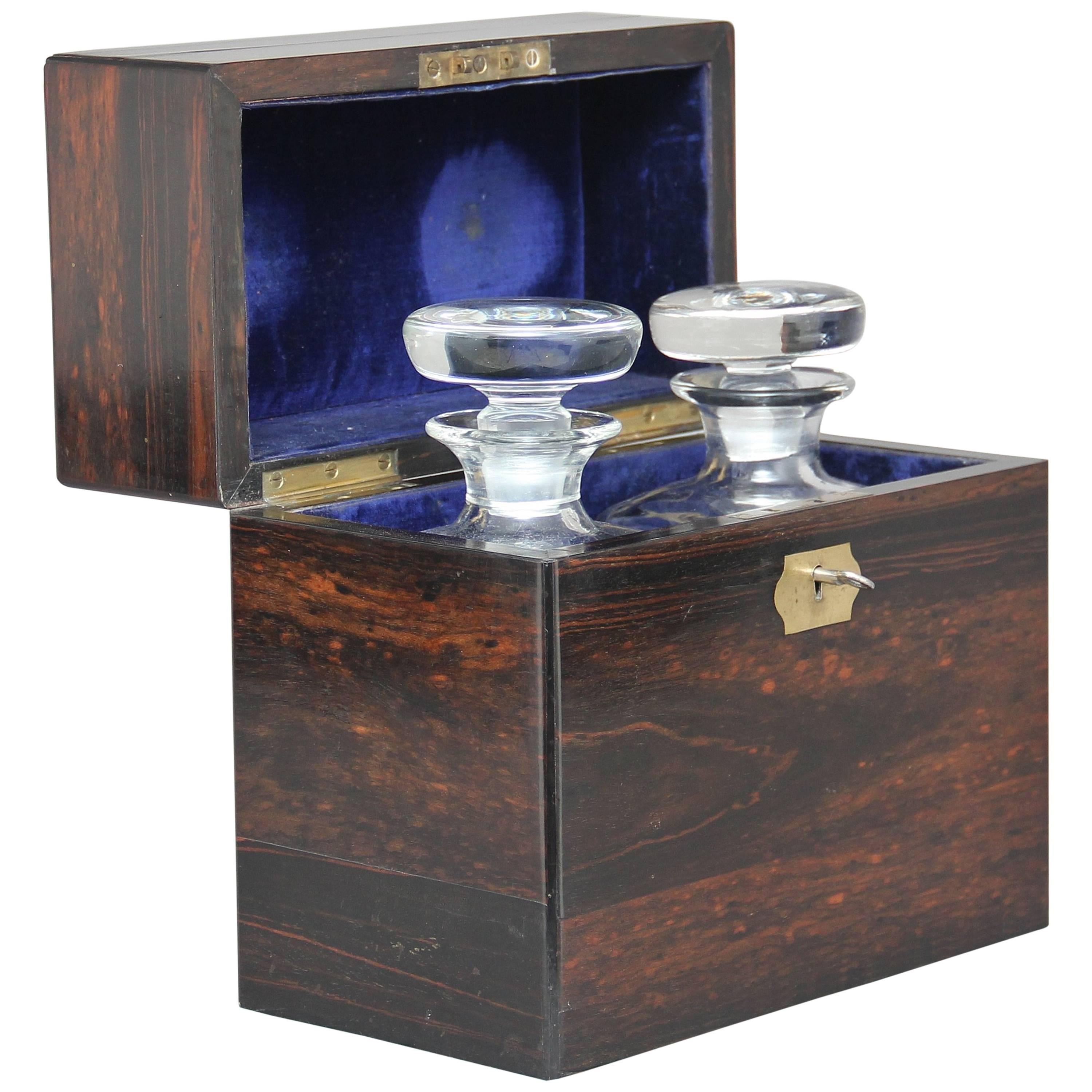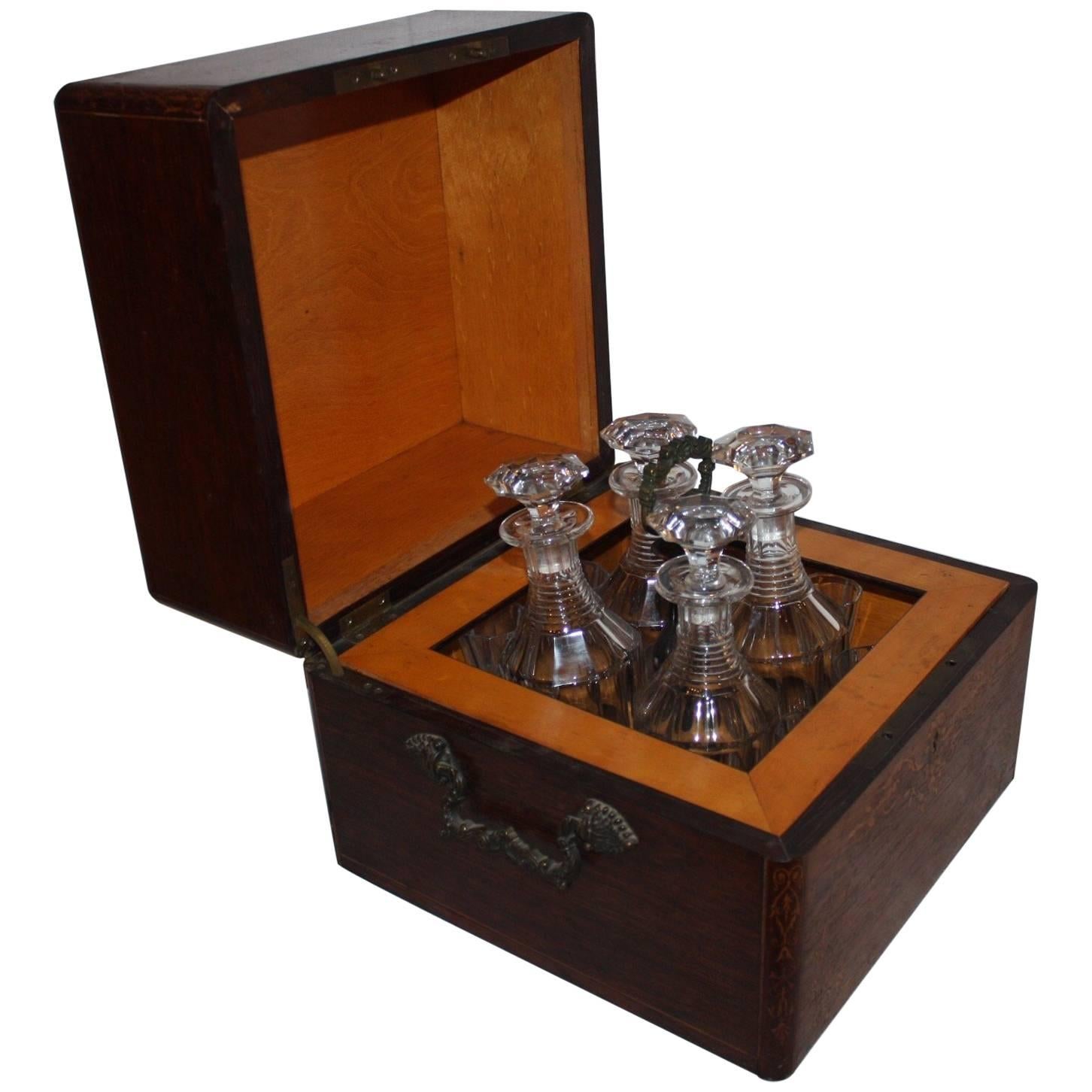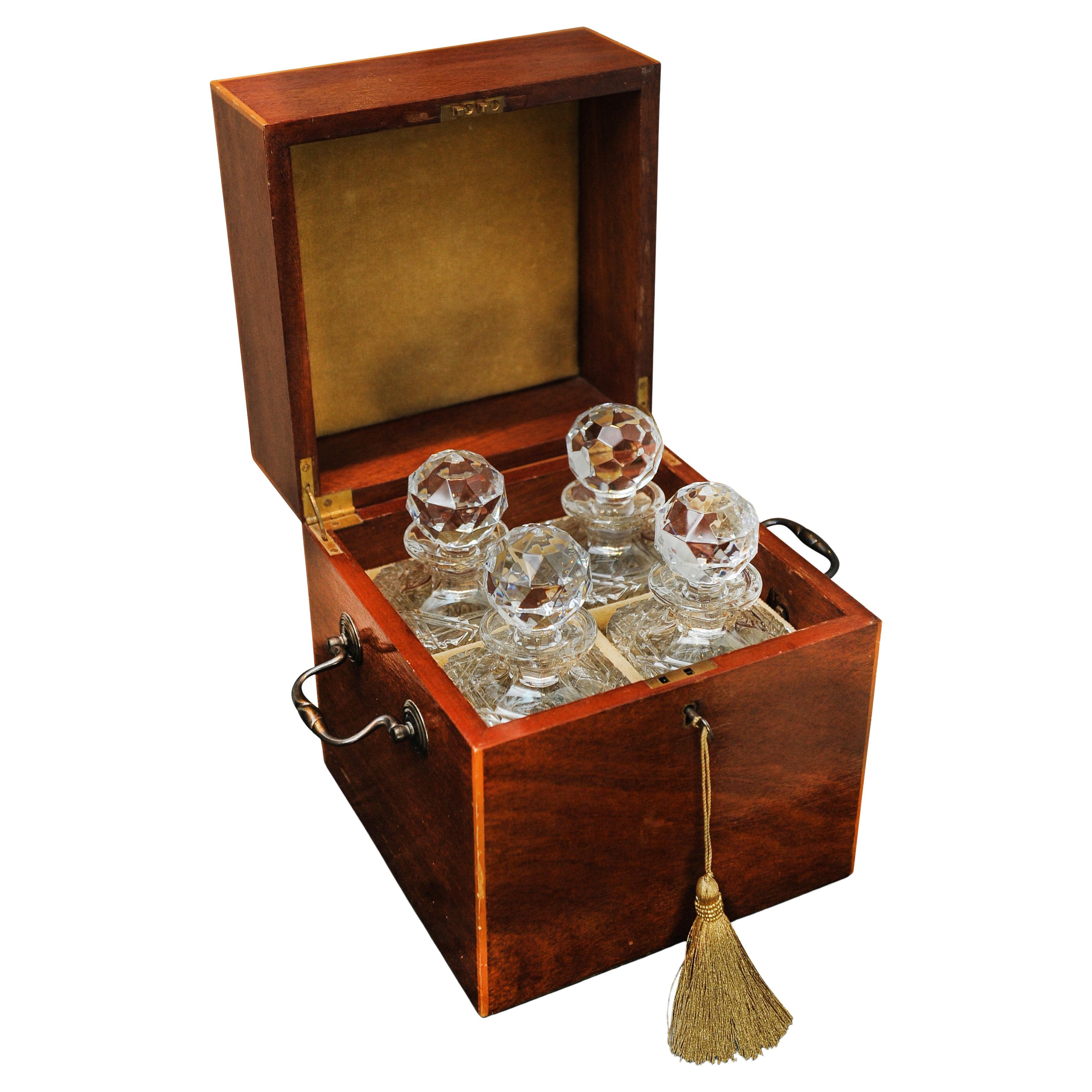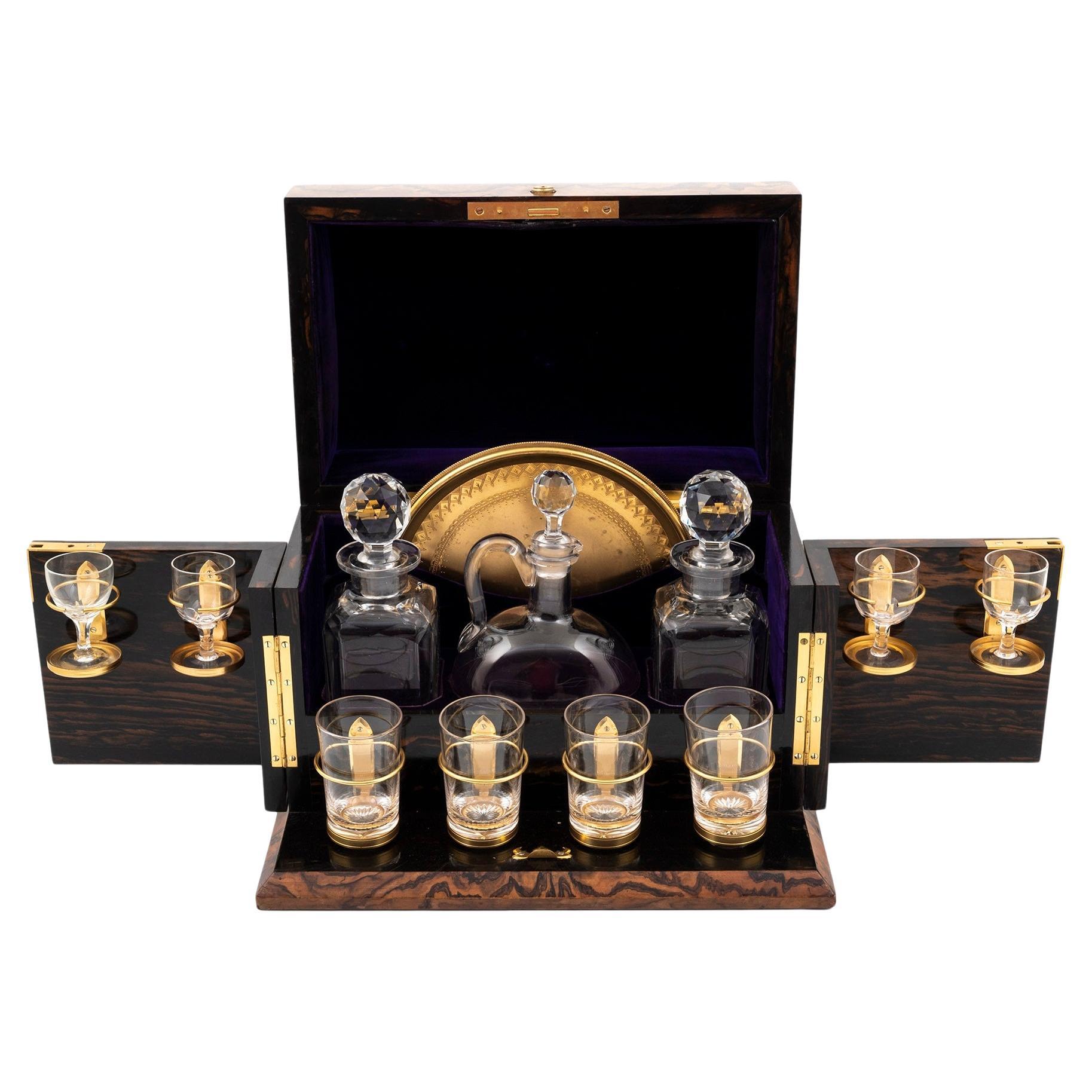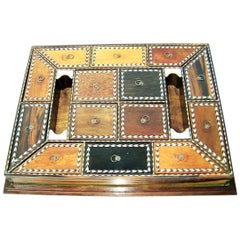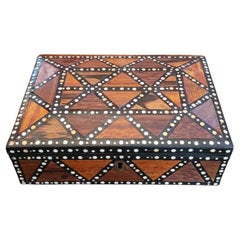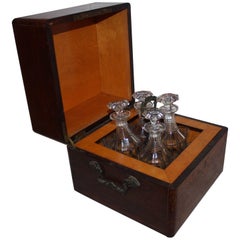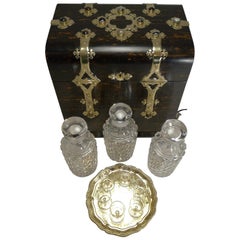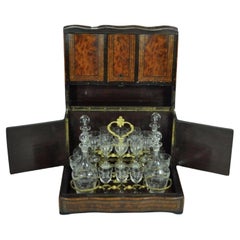Items Similar to 19C Irish Coromandel Wood Campaign Decanter Box
Want more images or videos?
Request additional images or videos from the seller
1 of 21
19C Irish Coromandel Wood Campaign Decanter Box
$4,250per set
£3,194.88per set
€3,703.88per set
CA$5,933.66per set
A$6,646.01per set
CHF 3,458.14per set
MX$80,715.38per set
NOK 43,840.46per set
SEK 41,366.74per set
DKK 27,636.19per set
Shipping
Retrieving quote...The 1stDibs Promise:
Authenticity Guarantee,
Money-Back Guarantee,
24-Hour Cancellation
About the Item
PRESENTING A STUNNING 19C Irish Coromandel Wood Campaign Decanter Box.
STUNNING mid-Victorian Decanter box from circa 1860-1880.
Made in Dublin, makers brass label on the interior, for ‘T.K. Austin & Co., Dublin’, the most famous top quality Merchant in Dublin in the mid to late 19th Century.
Made for Military Campaign purposes, it has brass recessed (fold-in) handles and brass banding on all edges.
Made of highly desirable Coromandel Wood from Ceylon (now Sri Lanka).
The lid opens on hinges that fix into position.
It is monogrammed on the top bearing the original owners initials.
The interior is lined with the original purple velvet and inside the top it has 4 brass hooks for attaching liquor glasses. We have found that Waterford Crystal Port Glasses fit perfectly.
The lock and fittings are all of the best quality and marked “R.C & S” in a Crown.
Being sold with contemporary Galway Irish Crystal Decanters, which fit perfectly and do not contain lead, so are safe to use !
As an ADDED BONUS, we are selling this with a number of silver liquor labels.
4 Sterling Silver Liquor Labels – Really nice set of 4 solid silver and hallmarked Liquor (Decanter) Labels. Hallmarked, English, Birmingham, Maker ’CR&S’.
‘Brandy’, ‘Port’ and Gin ‘labels’. Letter ‘g” for 1906.
“Vodka” label. Letter ”f” for 1905.
Also an earlier Silver plate (EPNS) example for the Scottish liqueur, ‘Drambuie’. Probably Scottish, circa 1900.
Also a matching pair of early 20C silver plate labels for ‘Whisky’ and ‘Sherry’.
Highly expensive piece when it was made and only a very wealthy 'Irish' Army officer could have afforded this !!
COROMANDEL WOOD: Calamander wood or Coromandel wood is a valuable wood from India, Sri Lanka (Ceylon) and South East Asia. It is of a hazel-brown color, with black stripes (or the other way about), very heavy and hard. It is also known as Macassar Ebony or variegated ebony and is closely related to genuine ebony, but is obtained from different species in the same genus; one of these is Diospyros quaesita Thwaites, from Sri Lanka. The name Calamander comes from the local sinhalese name, ‘kalu-medhiriya’, which means dark chamber; referring to the characteristic ebony black wood. It is used in furniture, Luthiery and for sculpture.
Coromandel wood has been logged to extinction over the last 2 to 3 hundred years and is no longer available for new work in any quantity. Furniture in coromandel is so expensive and so well looked after that even recycling it is an unlikely source. A substitute, Macassar Ebony, has similar characteristics and to the untrained eye is nearly the same but it lacks the depth of colour seen in genuine Coromandel.
- Dimensions:Height: 12 in (30.48 cm)Width: 9.75 in (24.77 cm)Depth: 9.75 in (24.77 cm)
- Sold As:Set of 12
- Style:Campaign (Of the Period)
- Materials and Techniques:
- Place of Origin:
- Period:
- Date of Manufacture:1860 - 80
- Condition:Repaired: Repair to crack on lid. Wear consistent with age and use. Minor fading. There is a crack on the top of the lid, which is quite common with coromandel wooden boxes due to shrinkage with age. The crack has been filled. Very minor repairs to the veneer on the base. But otherwise the box is very good. No key.
- Seller Location:Dallas, TX
- Reference Number:1stDibs: LU3978130866832
About the Seller
4.9
Vetted Professional Seller
Every seller passes strict standards for authenticity and reliability
Established in 2015
1stDibs seller since 2018
390 sales on 1stDibs
Typical response time: 2 hours
- ShippingRetrieving quote...Shipping from: Dallas, TX
- Return Policy
Authenticity Guarantee
In the unlikely event there’s an issue with an item’s authenticity, contact us within 1 year for a full refund. DetailsMoney-Back Guarantee
If your item is not as described, is damaged in transit, or does not arrive, contact us within 7 days for a full refund. Details24-Hour Cancellation
You have a 24-hour grace period in which to reconsider your purchase, with no questions asked.Vetted Professional Sellers
Our world-class sellers must adhere to strict standards for service and quality, maintaining the integrity of our listings.Price-Match Guarantee
If you find that a seller listed the same item for a lower price elsewhere, we’ll match it.Trusted Global Delivery
Our best-in-class carrier network provides specialized shipping options worldwide, including custom delivery.More From This Seller
View All19C Anglo Ceylonese Sewing Box of Museum Quality
Located in Dallas, TX
Presenting an absolutely stunning 19c Anglo Ceylonese sewing box of museum quality.
Made in Ceylon (now Sri Lanka) circa 1860, this is one of the finest sewing boxes of it’s kind that we have ever seen!
The box is made from coromandel wood (an exotic hardwood found in Ceylon) and has a serpentine edging all over the front, back and sides.
Very often the lids/tops of these boxes suffer cracks due to shrinkage but this one is near perfect with no crack in the lid/top. There is some evidence of natural shrinkage but that is around the edges of the lid/top.
It is when you open this box that it reveals it’s true beauty, quality and treasure !
The inside of the lid/top is heavily and beautifully decorated with inlaid bone in scrolling floral patterns which have then been hand painted with red and black ‘lac’ ink. The central medallion is a circle of inlaid specimen exotic hardwoods radiating towards a central bone and hand painted flower. The circle is edged in bone, wood and silver chevrons.
What makes this box Exceptionally rare is that it contains 3 lift out base sections. Normally, there would be a maximum of 2.
The first tray/section is clearly for the purposes ancillary to sewing with a pair of sections with bone spools for thread etc. There are 17 other lidded compartments with each one highly decorated using hand painted bone and specimen woods to replicate tortoiseshell.
The first tray lifts out to reveal a second removeable tray which is made up of a pair of open sections and 8 specimen wood lidded sections each with chevron banding.
The third tray is a smaller tray underneath with 14 lidded compartments each with hand painted bone and specimen wood inlaid lids again, replicating the look of tortoiseshell. Again they are banded with a chevron border.
This is a museum quality piece !
It is in fantastic condition for it’s age with the minor shrinkage to the edges of the lid/top, some finger pulls missing and some very minor cracks to the tray lids and bases but nothing that in any way detracts from the piece. No key.
Dimensions: Closed the box is 16.75 inches wide, 11.25 inches deep and 7.5 inches high
Fully open the box is 16.5 inches high, 16.75 inches wide and 11.4 inches deep
Anglo-Indian and ceylonese boxes: Anglo Indian boxes were made in India for the English residents from the early part of the 18th century. They were brought back or sent back to England usually by the people who had commissioned them. From the beginning of the nineteenth century they were imported more commercially, although not in any significant numbers until the middle decades. They were very highly valued, especially the early ones, to the extent that the designs were copied on late 19th and early 20th century tins.
Anglo-Indian boxes normally consist of 3 main types:-
(1) Most of the best and highest quality Anglo-Indian boxes in the 18th and 19th centuries were made in Vizagapatam, India, renowned for its exquisite craftsmanship in using ivory and tortoiseshell and lac decoration. These are referred to as ‘Vizagapatam Boxes...
Category
Antique Mid-19th Century Sri Lankan Anglo-Indian Decorative Boxes
Materials
Silver
19th Century Anglo Ceylonese Specimen Wood Desk Companion Tray
Located in Dallas, TX
Another stunning 19th century Anglo-Ceylonese piece.
Made circa 1880 in Ceylon (Now Sri Lanka) of Coromandel wood and specimen woods.
This is a simply gorgeous and quality item!! Tray made of various compartments with various high quality specimen wood lids, all edged and banded in chevrons of bone, silver or pewter and ebony.
The tray itself is made of expensive coromandel wood. There are two open sections on either side of the tray which have bone and hand-painted lac ends. The main tray sits onto a base made of coromandel wood with green baize lining.
This tray could have a number of practical uses, for keeping stationary, watches, jewelry, or thinking outside of the box, holding you remote controls and candy!!
We have a matching box also in our Inventory and for auction.
ANGLO-INDIAN AND CEYLONESE BOXES: Anglo Indian boxes were made in India for the English residents from the early part of the 18th century. They were brought back or sent back to England usually by the people who had commissioned them. From the beginning of the nineteenth century they were imported more commercially, although not in any significant numbers until the middle decades. They were very highly valued, especially the early ones, to the extent that the designs were copied on late 19th and early 20th century tins.
Anglo-indian Boxes normally consist of 3 main types:-
(1) Most of the best and highest quality Anglo-Indian boxes in the 18th and 19th Centuries were made in Vizagapatam, India, renowned for its exquisite craftsmanship in using ivory and tortoiseshell and lac decoration. These are referred to as ‘Vizagapatam Boxes...
Category
Antique Late 19th Century Sri Lankan British Colonial Decorative Boxes
Materials
Ebony, Wood
19C Anglo Ceylonese Specimen Wood Trinket Box
Located in Dallas, TX
PRESENTING A BEAUTIFUL and RARE 19C Anglo Ceylonese Specimen Wood Trinket Box.
Made in ‘Galle’, Ceylon (now Sri Lanka) circa 1860-80.
Made for the ex...
Category
Antique 19th Century Sri Lankan Anglo-Indian Jewelry Boxes
Materials
Bone, Hardwood, Ebony, Sandalwood
19c Anglo Indian Highly Carved Teak and Sandalwood Sarcophagus Sewing Box
Located in Dallas, TX
PRESENTING A VERY NICE 19C Anglo Indian Highly Carved Teak and Sandalwood Sarcophagus Sewing Box.
Made in Bombay, India circa 1890-1900.
The box case/body is made of sandalwood wit...
Category
Antique Late 19th Century Indian Anglo-Indian Decorative Boxes
Materials
Bone, Sandalwood, Teak
19C English Naval Captain's Sea Chest
Located in Dallas, TX
PRESENTING a GORGEOUS 19C English Naval Captain’s Sea Chest.
Made in Britain, probably England, circa 1851-55.
Early Victorian Era.
Made of...
Category
Antique Mid-19th Century English Early Victorian Blanket Chests
Materials
Oak
19th Century Anglo-Indian Spice or Tea Caddy with Silver Mounts
Located in Dallas, TX
PRESENTING A GORGEOUS 19C Anglo Indian Rosewood Caddy with Silver Mounts.
Really nice and unusual, 19th Century Anglo-Indian Spice or Tea Caddy, from cir...
Category
Antique Late 19th Century Indian Anglo Raj Tea Caddies
Materials
Sterling Silver
You May Also Like
19th Century Coromandel Decanter Box
Located in Martlesham, GB
A lovely quality 19th century coromandel decanter box with a recessed brass carrying handle on the top, a brass escutcheon on the front and a key f...
Category
Antique 1880s English Victorian More Dining and Entertaining
Materials
Wood
$1,051 Sale Price
20% Off
Beautiful Early 19th Century French Liqueur Box
Located in Stockbridge, GA
Beautiful early 19th century French liqueur box. It contains four bottles and eight glasses, Charles X period.
Category
Antique Early 19th Century French Charles X Decorative Boxes
Materials
Mahogany, Rosewood
Fine Antique English Coromandel Decanter / Drinks Box, circa 1880
By Betjemanns & Sons
Located in Bath, GB
A truly magnificent drinks / decanter box made from exotic Coromandel mounted with polished brass mounts inset with a plethora of different kinds of cabochon cut and polished onyx st...
Category
Antique 1880s English Late Victorian Barware
Antique French Brass Inlay Tantalus Box Cordial Decanter Set Liquor Cabinet
Located in Philadelphia, PA
Antique French Brass Inlay Tantalus Box Cordial Decanter Set Liquor Cabinet. Item features beautiful inlay to top of the box. Set includes 4 decanters...
Category
Antique Late 19th Century French Provincial Barware
Materials
Wood
Victorian Sheraton Revival Inlaid Decanter Box, With Four Atlantis Decanters
By Thomas Sheraton
Located in Reading, Berkshire
A Wonderful Antique Sheraton Revival Mahogany Decanter Box, With Four Atlantis Decanters & Decorative Inlay
The hinged lid with paterae and line inl...
Category
Antique 19th Century British Sheraton Glass
Materials
Cut Glass, Mahogany
Antique Burr Walnut Decanter Box Betjemann
By George Betjemann & Sons
Located in Northampton, GB
Always Free Worldwide Shipping
Outstanding Feathered Walnut Veneer
From our Decanter collection, we are thrilled to offer this rare example Antique Burr Walnut Decanter Box attrib...
Category
Antique Late 19th Century British High Victorian Decorative Boxes
Materials
Bronze
More Ways To Browse
Black Glass Box
Solid Silver Box
Black Crystal Box
Antique Band Box
Silver Box India
Dark Wood Antique Bedroom Furniture
Lock Box Silver
Antique Silver Plated Box
Antique Glass Hinged Box
Military Box
Coromandel Furniture
Antique Safe Box
Antique Scottish Wood Furniture
Brown Coromandel
Asian Handled Box
Brass Sculpture Box
Coromandel Wood
Black Decanters
